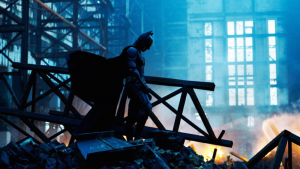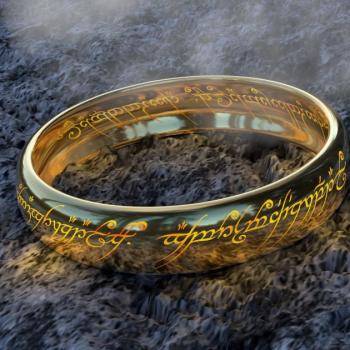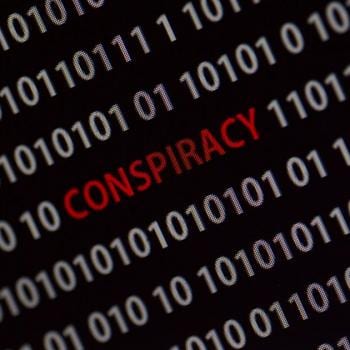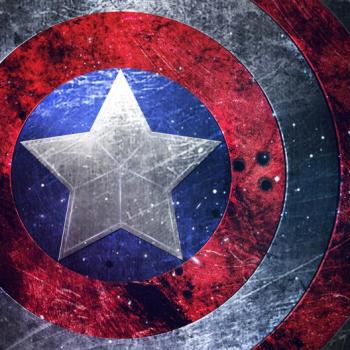Ten years after its most famous entry hit theaters, Christopher Nolan’s “Dark Knight” movies are still some of the best superhero films ever made. Here’s why.
In one online video which made the rounds a few years ago, a perceptive YouTuber combines clips from Christopher Nolan’s “Batman Begins,” “The Dark Knight” and “The Dark Knight Rises” with audio from the director’s 2006 “The Prestige.” Michael Caine (who also plays Batman’s plucky butler, Alfred), explains the three parts of a magic trick while the chapters of the Batman saga unfold before our eyes. It was a sharp connection for this YouTube user to make (one almost dares to wonder if Nolan intended it). The effect, whatever the case, is stunning:
“Every magic trick consists of three parts, or acts,” explains Caine as Cutter (though I hear him as Alfred). “The first part is called ‘the pledge.’ The magician shows you something ordinary—a deck of cards, a bird—or a man.”
[We see clips from Bruce Wayne’s childhood and troubled early years after his parents were murdered].
“He shows you this object,” continues Caine. “Perhaps he asks you to inspect it—to see that it is indeed real and unaltered—normal. But of course, it probably isn’t.”
[We see a montage of Wayne’s training under the ninja lord, Ra’s al Ghul, and the moment when he first dons the mask and cape of Batman to save Gotham City from his former teacher’s “justice”].
“The second act is called ‘the turn,”’ says Caine. “The magician takes the ordinary something, and makes it do something extraordinary.”
[We watch scenes from “The Dark Knight” of Wayne’s deadly chess game with Heath Ledger’s Joker, and witness as Batman accepts the stigma for crimes he didn’t commit].
“Now, you’re looking for the secret, but you won’t find it. Because of course, you’re not really looking. You don’t really want to know. You want to be fooled. But you wouldn’t clap yet. Because making something disappear isn’t enough. You have to bring it back. That’s why every magic trick has a third act—the hardest part. The part we call ‘the prestige.’”
[We see snatches of the final film: Gotham at war, skyscrapers crumbling, Wayne climbing from an abyss, surging from the darkness to meet his most frightening opponent yet.]
Ten years after the release of its most famous chapter, Nolan’s three-act Dark Knight saga remains the gold standard of superhero movies, not because of its dream-team of director, writers, actors, special effects artists and musicians, or its “grimdark” feel and success at grounding the Batman mythos in the real world. Rather, these movies enjoy an early and obvious immortality because they mimic the contours not just of a magic trick, but of redemption.
In “Batman Begins” (2005), Nolan introduces his “ordinary man,” a bereaved business heir caught on the horns of the story’s great dilemma. As the son of Gotham’s benefactor and would-be savior, Thomas Wayne, Bruce stands to inherit the noble work of renewing his city’s crime-ridden streets.
 But those streets have cost him. We all know the story of how Bruce Wayne’s parents were murdered in an alley by a common thief. Bruce leaves that alley with a thirst for revenge. For justice. Not only against his parents’ killer but against all killers. And in Nolan’s telling, Bruce finds a way to exact both through his training with the League of Shadows, the secret society behind the fall of major cities and civilizations that have become too decadent. When he realizes that the League’s orthodoxy excludes mercy, however, he abandons them and uses his training to fight for Gotham’s reclamation.
But those streets have cost him. We all know the story of how Bruce Wayne’s parents were murdered in an alley by a common thief. Bruce leaves that alley with a thirst for revenge. For justice. Not only against his parents’ killer but against all killers. And in Nolan’s telling, Bruce finds a way to exact both through his training with the League of Shadows, the secret society behind the fall of major cities and civilizations that have become too decadent. When he realizes that the League’s orthodoxy excludes mercy, however, he abandons them and uses his training to fight for Gotham’s reclamation.
Still, Bruce hasn’t yet reckoned with the depths of his city’s depravity. In “The Dark Knight” (2008), they come lurching out of the shadows as the Joker, one of the most unsettling portrayals of evil in any blockbuster. Ledger’s anarchistic take on the character cackles beneath face paint and grisly scars that he’s no monster, he’s just “ahead of the curve.” He delights in watching the world burn, not for its own sake but to prove a point: that morality, law, and order are illusions, propped up by deals the powerful have struck with their inner devils. Push anyone in the right way and at the right time, he insists, and that person will tumble into inhumanity.
The Joker demonstrates his philosophy on Gotham’s district attorney, Harvey Dent—who embodies Bruce’s hope that the city can redeem itself. Once Gotham’s “white knight” shows his sinister side, the Dark Knight chooses to take the blame for Dent’s crimes, rather than let the people lose hope.
Eight years later, crushed beneath this condemnation against his alter ego, Bruce hangs in limbo while Batman’s cowl hangs in his basement. “The Dark Knight Rises” (2012), opens with Thomas Wayne’s business empire crumbling, but Gotham seemingly in capable, legitimately-elected hands. The Dark Knight is no longer needed—or so Bruce thinks.
Into this eerie calm bursts “Gotham’s reckoning,” a drug-engorged monster named Bane who knows the truth about Harvey Dent and the Joker, and wants the world to know it, too. With overtones of the storming of the Bastille, Bane takes control of Gotham with a nuclear time bomb and releases its prisoners, while reading a letter that exposes the Harvey Dent deception.
But Bane, like Ra’as al Ghul before him, has a deeper scheme, conceived by the League of Shadows. He aims to make a spectacle of Bruce Wayne’s failure to redeem his corrupt city, and then to incinerate it. After defeating Batman, Bane deposits him in a hellish pit from which only one person has ever escaped. There, he provides Bruce with a way to watch Gotham destroy itself, fulfilling the original sentence against the corrupt city—a sentence Bruce, through mercy and hope, would not execute.
Of course, the Dark Knight does not stay in the pit. He rises, after three months (here Nolan risks being a little too on-the-nose), and returns to do what Batman was always meant to do: defeat the evil his city could not, and accept the consequences of its sin, himself.
What starts out looking like pledge, turn, and prestige might be better summarized as baptism, passion, and resurrection. The “Dark Knight” movies plunge us right into the paradox of justice and mercy. Like Victor Hugo’s Inspector Javert, the arch-villains of Nolan’s trilogy aren’t hardened criminals, but vigilante-philosophers devoted to a strict code of justice against the wickedness of man. Pharisee-like, they tie up heavy burdens which they themselves will not lift a finger to move. Even the Joker, while no legalist, embodies a sort of perverse honesty. He wants to hold up a mirror to the people of Gotham and show them how ugly they really are.
Most stories turn on good versus evil. But bound up with the imagery of Batman and his opponents is the immemorial grappling match between holiness and grace. Bruce Wayne’s decision to take crime-fighting into his own hands when Gotham’s government failed is not so much an apology for extrajudicial justice as it is a reminder that we need a savior from our neighborhood.
Bruce at first sees Batman as a temporary measure—a symbol to unite his fellow citizens against their city’s decay. But he quickly becomes more than a symbol. He becomes the vicarious means by which Gotham is saved—the would-be judge descended to earth to accept his own sentence—a hypostatic union, if you will, between the stuff of Gotham and the stuff of her godlike judges.
This is why it’s so important that Nolan offers us no Superman, no bulletproof savior who throws aside our problems and flashes a dashing smile as he soars away. He offers us a man—one we see fall down, bleed, and weep. This Batman is not a deus ex machina, but an atonement figure. And he is why, ten years after “The Dark Knight” hit theaters, this series of superhero movies still deserves its prestigious reputation.
Image: Warner Bros. Pictures












